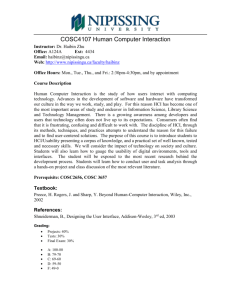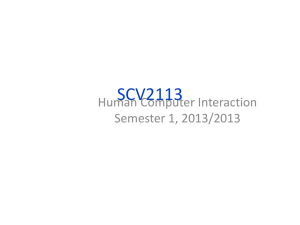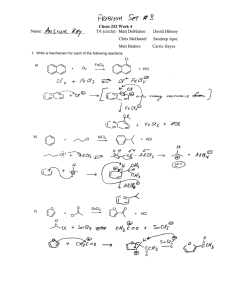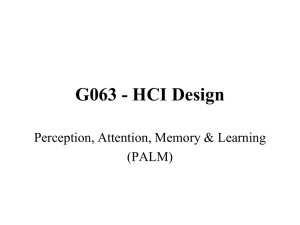CS305, HCI in Software Development
advertisement
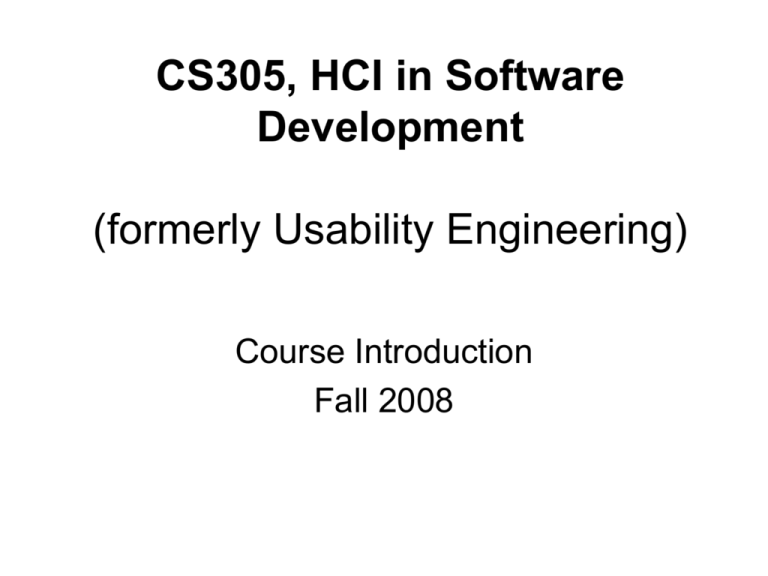
CS305, HCI in Software Development (formerly Usability Engineering) Course Introduction Fall 2008 There must be a problem because… What’s the Course About? • In one sentence: – Human-computer interaction (HCI) and usercentered design in the context of SW engineering • Note the target audience: – Students who may be involved in SW development – HCI is important to others: HW designers and engineers, Web designers, psychologists, etc. – But CS305 targets SW development What is HCI? • More soon… • Human-Computer interface – Where people “meet” or come together with machines or computer-based systems – Physical interface (e.g. buttons, screens, menus, etc.) – Logical interface • The model a system presents a user • Set of tasks available and how they’re organized From the SIGCHI Website • HCI is… – An inter-disciplinary discipline (engineering, CS, psychology, graphic design, ergonomics, etc.) – Concerned with design, evaluation, and implementation – Addresses people’s needs, capabilities, limitations SIGCHI curriculum definition site Human-computer interaction is a discipline concerned with the design, evaluation and implementation of interactive computing systems for human use and with the study of major phenomena surrounding them. What is an interface? ? Evolution of HCI ‘interfaces’ • 50s - Interface at the hardware level for engineers switch panels • 60-70s - interface at the programming level COBOL, FORTRAN • 70-90s - Interface at the terminal level - command languages • 80s - Interface at the interaction dialogue level GUIs, multimedia • 90s - Interface at the work setting - networked systems, groupware • 00s - Interface becomes pervasive – RF tags, Bluetooth technology, mobile devices, consumer electronics, interactive screens, embedded technology, information appliances HCI: Wide Range of Concerns • Make an interactive system be useful for a task, and support that task effectively – Easy to use, easy to learn, avoid errors – Must understand users, understand users’ tasks • Create a usable logical interface – A user’s conceptual model of the system – Overall design of how we interact • Physical and low-level design – Physical interface: buttons, keys, screens – SW interface: menus, screens, colors • Evaluating usability – During development, after completion High-level Terms • HCI, CHI • Usability • User-centered Design – An approach to design (SW, Web, other) that involves the user a great deal, in many phases • Interaction Design (ID) – Something different than HCI? Maybe. – Our current textbook is an an “ID” text Usability • A definition from ISO standard 9241 – The extent to which a product can be used by specified users to achieve specified goals with effectiveness, efficiency and satisfaction in a specified context of use. • Effectiveness: – accuracy and completeness in achieving goals • Efficiency: – resources expended… • Satisfaction: – comfort, acceptability (happiness, pleasure) Discussion • Effectiveness, efficiency and satisfaction: – Are all of these equally important? – All the time? What is User-Centered Design? • An approach to UI development and system development. • Focuses on understanding: – Users, and – Their goals and tasks, and – The environment (physical, organizational, social) • Pay attention to these throughout development ISO on User-centered Design • ISO 13407 describes human-centered design processes for interactive systems • Principles of human-centered design: – Active involvement of users – Appropriate allocation of function between user and system – Iteration of design solutions – Multidisciplinary design teams ISO on User-centered Design (2) • Essential activities in human-centered design: – Understand and specify the context of use – Specify the user and organizational requirements – Produce design solutions (prototypes) – Evaluate designs with users against requirements Are You Experienced? (in UC Design, I mean) • Think about a significantly complex software project you’ve been involved in – Work, research, CS340, etc. • Did it seem like an example of usercentered design? – How did it, or how did it not? What is interaction design? • Designing interactive products to support people in their everyday and working lives – Sharp, Rogers and Preece (2002) • The design of spaces for human communication and interaction – Winograd (1997) Goals of interaction design • Develop usable products – Usability means easy to learn, effective to use and provide an enjoyable experience • Involve users in the design process Unclear about what ID is? • Not surprising! • We’ll read: – What is Interaction Design and What Does It Mean to Information Designers? by Craig Marion – http://www.chesco.com/~cmarion/PCD/WhatIsInteractionDesign.html • and – From Computing Machinery to Interaction Design by Terry Winograd – http://hci.stanford.edu/%7Ewinograd/acm97.html From HCI to Interaction Design • Human-computer interaction (HCI) is: “concerned with the design, evaluation and implementation of interactive computing systems for human use and with the study of major phenomena surrounding them” (ACM SIGCHI, 1992, p.6) • Interaction design (ID) is: “the design of spaces for human communication and interaction” (Winograd, 1997) • One distinction: more application areas, more technologies and more issues to consider when designing ‘interfaces’ Relationship between ID, HCI and other fields Academic disciplines (e.g. computer science, psychology) Design practices (e.g. graphic design) Interaction Design Interdisciplinary fields (e.g HCI, CSCW) Relationship between ID, HCI and other fields • Academic disciplines contributing to ID: – Psychology – Social Sciences – Computing Sciences – Engineering – Ergonomics – Informatics Relationship between ID, HCI and other fields • Design practices contributing to ID: – Graphic design – Product design – Artist-design – Industrial design – Film industry Relationship between ID, HCI and other fields • Interdisciplinary fields that ‘do’ interaction design: – – – – – – HCI Human Factors Cognitive Engineering Cognitive Ergonomics Computer Supported Co-operative Work Information Systems What do professionals do in the HCI or ID business? • interaction designers - ?? • usability engineers - ?? • web designers – (we know this one!) • information architects - ?? • user experience designers - ?? What do professionals do in the HCI or ID business? • interaction designers - people involved in the design of all the interactive aspects of a product • usability engineers - people who focus on evaluating products, using usability methods and principles • web designers - people who develop and create the visual design of websites, such as layouts • information architects - people who come up with ideas of how to plan and structure interactive products • user experience designers - people who do all the above but who may also carry out field studies to inform the design of products Reminder: What is involved in the process of UC/ID design • Identify needs and establish requirements • Develop alternative designs • Build interactive prototypes that can be communicated and assessed • Evaluate what is being built throughout the process (This is what you’ll do this semester!) Class Activity • Think-Pair-Share: – Pairs write down differences – Pairs merge results – Instructor calls on pairs to share answers • Question: – Think about a hard-to-use software product (or computer-based system). – In what way does it have poor usability? • General problems • Specific examples Bad Interfaces, Fall 08 Bad Interfaces, Spr 08 • SMOK – Zooming hard, not intuitive • Do it too much, overlap, too much scrolling – Sometimes right-click, other times do something else • Some commands buried – Default when adding component bad, things overlap, – Things you need to find not labeled well • Too much zooming, search to find things • Add tings and file is lost – Components/things easily deleted by mistake • Failed to always load file correctly • Demands advance planning, otherwise hard to change things later • Hard to distinguish arrows between components where there are many Excel • Copy and paste from Word puts stuff in just one cell • Hard to change details in graphs – Wizard great, but hard to see how to customize – 2D graphs • Print formatting • Steep learning curve – Hard for beginners needing advanced features • Click on cell, selects all, and you may delete it when you mean to edit it • Formulas: hard to follow which cells are referenced • Floating point accuracy Fake iPod • Different buttons are used to select at different times • Mistake takes you back to beginning instead of back one • Can’t define order of songs when playing ISIS • Type in year/semester: use odd format – Could default to “logical” semester • Doesn’t have all info in it to be good – Need COD which isn’t there • Waitlist isn’t well integrated • Availability: closed at certain times (?) • Can’t press enter to login in, must click – Also, tab order isn’t logical • Must return back to main menu always, even when there’s a logical other window you want to do • Can’t use Backspace/Back to go back • Close window causes it to chide you • Audit have this request/wait/return option – Seems unfriendly, unresponsive • Timer period too short since you have to use >1 system • Refresh -- F5 logs you out Examples of non-usable systems • Kroger’s self-checkout – Use of the scale is confusing, not enough room for stuff – Slow scanners, not as efficient as you’d hope • Slow to scan/place/wait, so takes longer – Default fix is “get cashier”, no other suggestions • Poor error recovery – Why can’t I swipe student ID? Didn’t check if you were a student once • Ableton-Live or similar recording/audio software – doesn’t look like standard Windows program, so hard to find GUI controls – might look cool but makes it less efficient • Games that used keyboard commands only and used card-board cut-out • Chem151 HW checker program – Can’t backtrack in the steps you have to do – Crashes a lot – Didn’t accept numeric answers missing x.0 • No feedback on why • UVa’s Webmail – Ugly to look at, not pleasing – hard to keep mail organized in folders • Must explicitly copy and move – Slow – Useless spam filter – Must log into webmail/toolkit even when you’ve logged into a machine – Filters out mail headers / not clear you can control this – Indents messages in a thread, but if too deep you don’t see enough of the message • Mathcad – hard to learn at first – hard to keep track of variable / whole thing fails because of one small error / not good at explaining source of errors – use of arrow-keys vs. space-bar to move things in an equation • expected arrow keys to work – 4+ different versions of the equals-sign / hard to distinguish on the screen – new version can’t read files from other versions – hard to remember after not using it for a while (lots of tricks needed, hard to remember) • ISIS – – – – – – – – – – – – pops up a window, pop-up blocker problems can’t use browser’s back button gives course instructor number instead of name must enter schedule-number instead of clicking on course ID and number Must use semester as a code, and if you get this wrong it’s confusing what’s wrong Interface has pictures/images for links, not the conventional under-lined links not integrated into COD, so must copy info over from COD to ISIS Kicks you off too quickly Too often overloaded, too many users Unavailability at certain hours / don’t know when it’s unavailable / status not visible easily Links on main page are too similar SSN number use Spring 06: Examples of nonusable systems • Eclipse – Hard learning curve, bad for beginners – Too many windows, confusing layout, too much going on (advanced options) • Mathcad – Interface not intuitive – Not monkey-proof (let’s you make mistakes that crash it, make it unstable) – Saving didn’t always work well – Mouse scrolling caused program to crash • Main UVa website – – – – Cluttered, too much stuff Random, not organized Things you need small, hard to find – must search for [User-base…] • Grad school application sites – Multiple systems, not standard – Important info not clear, not consistent (deadlines) • Geometer’s Sketchpad – Hard to figure out how to use (sit down, can’t figure out what to do). Need to read instruction book. Bad help • AOL IM – Flashing movies, ads – Opens up another window – Unwanted info, windows, distracting – Adds buddies to your buddy list (can’t remove) • vi – Not intuitive, need instructions – Simple function but needlessly complex ISIS • ISIS – Have to type in year, semester (no drop downs). Cryptic input, better output – Must enter course number – Hit back, closes windows, must log-in again – Boots you off for no reason. Doesn’t handle heavy loads well. – Must disable popup blocker. – Not available at night. Data not current. – Doesn’t integrate with COD well. – Inputs don’t match outputs. – Won’t let you drop below 15 credits. Get stuck. End of lecture 1



